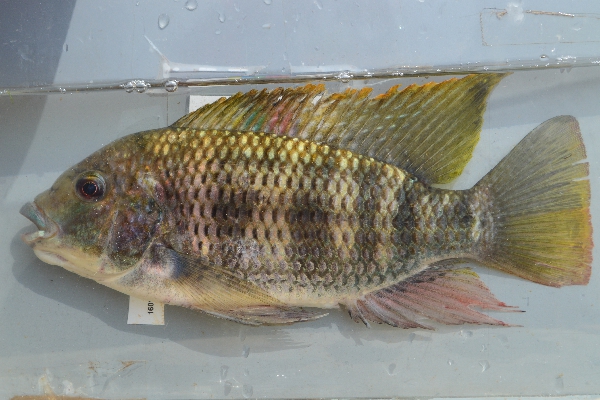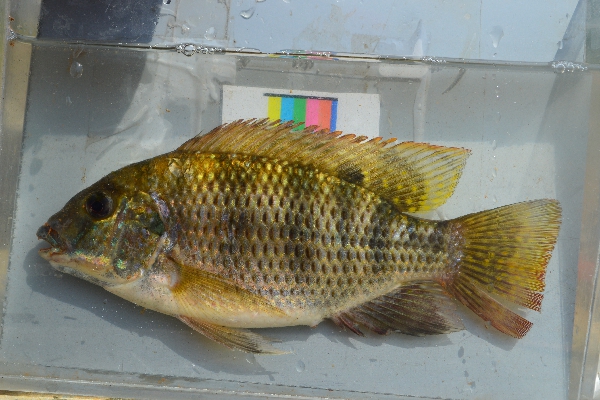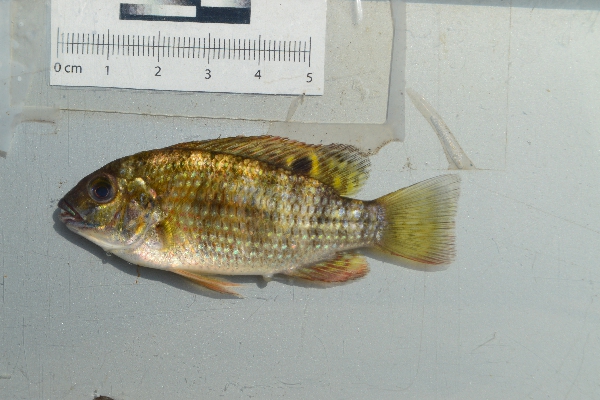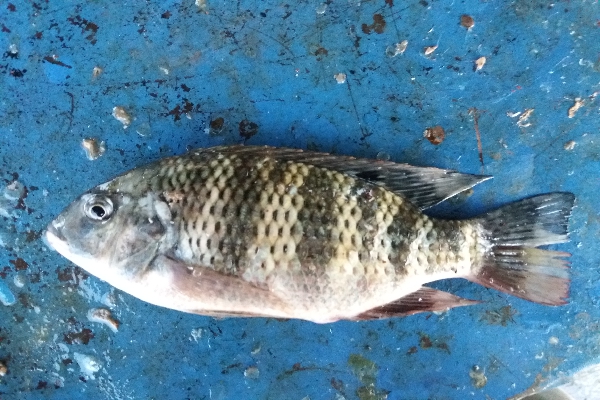Common names:
Redbelly tilapia
Lunyankole: Nyalubondo
Taxonomic tree
Kingdom: Animalia
Phylum: Chordata
Class: Actinopterygii (ray-finned fish)
Order: Cichliformes (Cichlids)
Family: Cichlidae (Cichlids)
Genus: Coptodon
Species: Coptodon zillii (Gervais, 1848)
Number of Occurrancies: 642
Etymology(based on Scharpf & Lazara, 2018)
- Coptodon: copto-, meaning split or divided; odon, meaning tooth; presumably referring to bifid maxillary teeth of C. zillii.
- zillii: in honor of M. (probably Monsieur) Zill, the “distinguished naturalist” (translation) who collected type and sent it to Gervais
Synonyms: click here to view synonyms
Type locality: Algeria [North Africa]. Syntypes formerly at Muséum national d'Histoire naturelle (MNHN) (lost)
General identification features for tilapiine cichlids
- A single nostril on each side of the head; dorsal fin with contineous spinous and soft-rayed parts; lateral line interrupted(with anterior superior part and posterior inferior part)
- Cycloid scales
- Tilapia mark (dark spot at the posterior end of the dorsal fin) in juveniles
Distinguishing characters for the genus
- Fewer gillrakers (usually 10-17) on the first gill arch
- 23–29 scales in the longitudinal row; the scales are small near base
- Upper and lower outer teeth rows bicuspid in both jaws, inner rows with smaller tricuspid teeth in both jaws; stout non spatulate teeth; isognathous
- 6–8 vertical bars on flanks (when distinct), some, or all of them are branched (Y-shaped) close to dorsal fin
- pointed pelvic fins
- “tilapia spot” in dorsal fin; this usually dissapears in adult fishes, but not C. zillii
- No hump on forehead, no expanded tissue on the roof of the pharynx (“visor-like hanging pad”)
- Nest spawners, with no marked sexual dimorphism and discromatism (sexual differences related to size and color respectively) at breeding time
Distinguishing characte for the species
- Deep bodied species (depth contained 2-2.75 times in the standard length) easily recognised by its very low gill raker count (8-12) (Diagnostic)
- Distinctive Tilapia-mark on the dorsal fin which persits in adult fishes (large, black, nearly circular spot almost completely outlined in yellow) (Diagnostic)
- Colour is variable: Typically, body olivaceous, short with an iridescent blue sheen; lips bright green; chest pinkish (black surmounted by an intensely crimson flush in breeding fishes). Dorsal, caudal, and anal fin olivaceous with yellow spots, the dorsal and anal fins often outlined by a narrow. Coloration of breeding fishes is more intense than non-breeders
- 6 or 7 verticle bars, of varibale intensity, may be seen on the ody and caudal peduncal
Taxonomic notes: This species closely resembles Coptodon rendalli, but C. rendalli has a steeper head profile (and a small head and mouth) and less prominent vertical bars; the tailfin of C. rendalli is also often divided into a brownish (sometimes) spotted upper part and yellowish lower part, whereas that of C. zillii is uniform and spotted. This species has been introduced in many systems in the Lakes Victoria and Kyoga basins, and is widely reported in old literature as Tilapia zillii.
Distribution in Uganda: Occurs naturally in Lake Albert and some crator lakes in Western Uganda, but was also introduced in many other systems, notably Lakes Victoria and Kyoga basins (see the map) in the mid-1950s.
Occurence: Native/Introduced
Habitat: Benthopelagic; common in shallow inshore waters, especially in sheltered bays, with muddy bottom and abundant vegetation
Feeding: Herbivore, feeding principally on leaves and stems of rooted aquatic plants and their associated epiphytic algae. It also feeds on bottom deposits in lakes with no submerged vegetation
Biology: Breeding takes place througout the year, but generally peaks in rainy season. Spawning takes on firm clear substrates close inshore. Copton zillii belongs to the groug of "Tilapias" which are not mouth brooders. Spawning takes place in a prepared nest-a deprssion in the bottom; thereafter one of the parents remains on guard, constantly cleaning the eggs of any detritus which may settle on them and maintaining a current of water over the nest. Newly hatched C. zillii are smaller than the larvae of mouth-brooding species and are provided with an adhesive organ on the head. By means of an excretion from this organ the young attach themselves to plants and stones. In Lake Victoria, the smallest fishes were 15 cm and 13 cm standard length (SL) in males and females, repsectively. All fishes above 18 cm ST have been found to be mature. Fecundity ranges from 1000-7061 eggs in fishes of 8-19 cm TL. The species attains about 12 cm TL by the end of the first year, which doubles by the end of the third year.
Economic importance/End use: This species is not abundant in catches as Oreochromis niloticus, but is an important component in the subsistence fisheries.
IUCN conservation status: click here to view IUCN status
Threats: Fishing; destruction of inshore fringing vegetation where the species breeds
Main references
- Greenwood PH. 1966. The fishes of Uganda. The Uganda Society, Kampala. 131 pages.
- Dunz AR, & Schliewen UK, 2013. Molecular phylogeny and revised classification of the haplotilapiine cichlid fishes formerly referred to as “Tilapia.” Molecular Phylogenetics and Evolution, 68(1), 64–80. doi:10.1016/j.ympev.2013.03.015
- Sharpf C, Lazara J.K. 2018. Fish Name Etymology Database v1. www.etyfish.org
- Witte F & van Densen W.L.T. 1995. Fish Stocks and Fisheries of Lake Victoria: a handbook for field observations. Samara Publishing Limited, Netherlands






